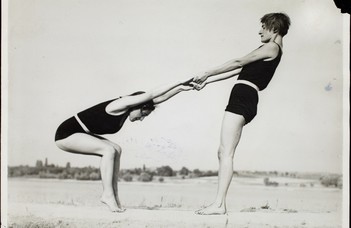Healing Professions Workshop I.
Katalin Detre's presentation on the autonomy of movement artists

 A particular feature of Hungarian physiotherapy is that it has developed in close interaction with modern dance in terms of content, individuals and institutions. The modern dance movements, which were distinct from classical ballet, began to use the term movement art as a common name from the mid-twenties onwards. The fact that by the end of the decade this category had been extended to all modern therapeutic gymnastics in Hungary had its own reasons, and individual and professional autonomy played no small part in this. At the beginning of the twenties, the demand for women's gymnastics schools increased strongly due to changes in lifestyle and fashion. The benefits of this increase in demand were clearly felt in the new, more modern trends, closer to the needs of the female body and soul, which were detrimental to the interests of the traditional male gymnastics practitioners under state control. In 1929, when the state began to regulate public dance and gymnastics education together, the Ministry of Culture sought to give preference to the employment opportunities of graduates of the College of Physical Education under its jurisdiction over competing trends.
A particular feature of Hungarian physiotherapy is that it has developed in close interaction with modern dance in terms of content, individuals and institutions. The modern dance movements, which were distinct from classical ballet, began to use the term movement art as a common name from the mid-twenties onwards. The fact that by the end of the decade this category had been extended to all modern therapeutic gymnastics in Hungary had its own reasons, and individual and professional autonomy played no small part in this. At the beginning of the twenties, the demand for women's gymnastics schools increased strongly due to changes in lifestyle and fashion. The benefits of this increase in demand were clearly felt in the new, more modern trends, closer to the needs of the female body and soul, which were detrimental to the interests of the traditional male gymnastics practitioners under state control. In 1929, when the state began to regulate public dance and gymnastics education together, the Ministry of Culture sought to give preference to the employment opportunities of graduates of the College of Physical Education under its jurisdiction over competing trends.
The new regulation placed the rhythmic and hygienic gymnastics disciplines under the jurisdiction of the College of Physical Education, where both the admission requirements and the curriculum were determined by the Ministry, and also provided for supervision by the Ministry of the Interior. The new legislation thus completely removed the professional autonomy of these disciplines and made them economically impossible. News of the regulation leaked out, and the school owners, who had hitherto been operating independently of each other, joined forces, set up a professional advocacy organisation, the Movement Culture Association, and successfully mobilised their national and international networks. The new state regulations that were negotiated "separated the art of movement from rhythmic gymnastics, recognised its formal autonomy and equality with the other branches of dance" and placed the teaching and admission to the profession entirely within the competence of the profession. The representatives of the gymnastics disciplines excluded from the scope of the decree defended themselves against their own discrimination by referring to "artistic objectives" which, in principle, separated them from gymnastics. In this way they managed to gain a livelihood in the name of 'movement art' and, by completing a final course at the Ministry of the Interior, obtained a diploma authorising them to open a private school. As a result of this life-saving action, all modern physiotherapy gymnastics were also called "movement arts".
The confusion was exacerbated by the fact that some gymnastic schools (especially the Madjar and Karman schools), partly for the sake of appearances and partly out of amateur enthusiasm, had thrown themselves into artistic work alongside orthopaedics and hygienic gymnastics, and had infused the revolutionary, front-end character of "movement art, already endangered from an artistic point of view, with amateurism." In retrospect, it is difficult to judge to what extent Olga Szentpál, who recalled the events in 1947, was able to judge the artistic productions of her competitors impartially, since no film footage of the performances has survived. However, the surviving photographs and reviews suggest that the movement material of the gymnastics schools was a source of access to the art of dance. The Mensendieck gymnastics, based on muscle awareness, the multi-directional development of body parts, especially small joints, and the extensive use of the dynamic potential of movement, proved to be a good basis for expressive movement.
Ödön Palasovszky recognized this opportunity and from 1926, three years before the 1929 BM decree, he included the Madzsar School in his Avatgard theatre experiments (New Earth Evenings 1926-1927, Cik-cakk Evenings (1928) Extraordinary Stage 1928, Prism Stage 1928-1929).The other question is how successful these experiments were then and there. Lajos Kassák also expressed a reserved opinion about the productions. However, the success or failure of the early experiments did not affect the essence of the method. Kassák's foster daughter, the dancer Etel Nagy, "who had been a pupil of Gertrud Krauss in Vienna, chose as her master in Budapest the movement artist Maria Ritter, who "taught almost gymnastic movement without any semblance of artistic pretension, on an honest anatomical basis."

